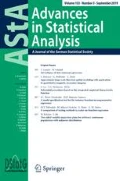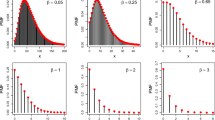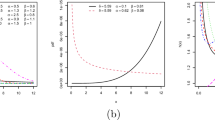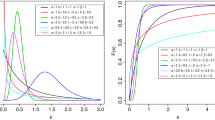Abstract
In this paper, we further study the Conway–Maxwell Poisson distribution having one more parameter than the Poisson distribution and compare it with the Poisson distribution with respect to some stochastic orderings used in reliability theory. Likelihood ratio test and the score test are developed to test the importance of this additional parameter. Simulation studies are carried out to examine the performance of the two tests. Two examples are presented, one showing overdispersion and the other showing underdispersion, to illustrate the procedure. It is shown that the COM-Poisson model fits better than the generalized Poisson distribution.
Similar content being viewed by others
References
Atkinson, A.C., Yeh, L.: Inference for Sichel’s compound Poisson distribution. J. Am. Stat. Assoc. 77, 153–158 (1982)
Cancho, V.G., Castro, M., Rodrigues, J.: A Bayesian analysis of the Conway–Maxwell–Poisson cure rate model. Stat. Pap. 53(1), 165–176 (2012)
Consul, P.C., Jain, G.C.: On some interesting properties of the generalized Poisson distribution. Biometrische Z 15, 495–500 (1973)
Consul, P.C.: Generalized Poisson Distributions. Marcel Dekker, New York (1989)
Gupta, P.L., Gupta, R.C., Tripathi, R.C.: On the monotonic properties of discrete failure rates. J. Stat. Plan. Inference 65, 255–268 (1997)
Gupta, P.L., Gupta, R.C., Ong, S.H., Srivastava, H.M.: A study of Hurwitz–Lerch-Zeta distribution with application. Appl. Math. Comput. 196(2), 521–531 (2008)
Gupta, P.L., Gupta, R.C., Tripathi, R.C.: Score test for zero inflated generalized Poisson regression model. Commun. Stat. Theory Methods 33(1), 47–64 (2004)
Gupta, P.L., Gupta, R.C., Tripathi, R.C.: Analysis of zero adjusted count data. Comput. Stat. Data Anal. 23, 207–218 (1996)
Gupta, R.C.: Modified power series distributions and some of its applications. Sankhya Ser. B 36, 288–298 (1974)
Gupta, R.C.: Maximum likelihood estimation of a modified power series distribution and some of its applications. Commun. Stat. Theory Methods 4, 689–697 (1975)
Gupta, R.C., Ong, S.H.: A new generalization of the negative binomial distribution. Comput. Stat. Data Anal. 45(2), 287–300 (2004)
Gupta, R.C., Ong, S.H.: Analyses of long-tailed count data by Poisson mixtures. Commun. Stat. Theory Methods 34(3), 557–573 (2005)
Hasselblad, V.: Estimation of finite mixtures of distributions from the exponential family. J. Am. Stat. Assoc. 64, 1459–1471 (1969)
Kadane, J.B., Krishan, R., Shmueli, G.: A data disclosure policy for count data based on the COM-Poisson distribution. Manag. Sci. 52(10), 1610–1617 (2006a)
Kadane, J.B., Shmeuli, G., Munka, T.P., Borle, S., Boatwright, P.: Conjugate analysis of the Conway–Maxwell–Poisson distribution. Bayesian Anal. 2(2), 363–374 (2006b)
Kokonendji, C.C., Mizere, D., Balakrishnan, N.: Connections of the Poisson weight function to overdispersion and underdispersion. J. Stat. Plan. Inference 138, 1287–1296 (2008)
Kemp, A.W.: Classes of discrete lifetime distributions. Commun. Stat. Theory Methods 33, 3069–3093 (2004)
Lee, P.A., Ong, S.H., Srivastava, H.M.: Some integrals of products of Laguerre polynomials. Int. J. Comput. Math. 78, 303–321 (2001)
Metropolis, N., Rosenbluth, A.W., Rosenbluth, M., Teller, A.H., Teller, E.: Equation of state calculations by fast computing machines. J. Chem. Phys. 21, 1087–1092 (1953)
Minka, T.P., Shmueli, G, Kadane, J.B., Borle, S., Boatwright, P.: Computing with the COM-Poisson distribution. Technical Report #776, Department of Statistics, Carnegie Mellon University. http://www.stat.cmu.edu/tr/tr776/tr776.html (2003)
Mullahay, J.: Heterogeneity, excess zeros, and the structure of count data models. J. Appl. Econ. 12, 337–350 (1997)
Ng, C.M., Ong, S.H., Srivastava, H.M.: Parameter estimation by Hellinger type distance for multivariate distributions based on probability generating functions. Appl. Math. Model. 37, 7374–7385 (2013)
Ord, J.K., Whitmore, G.A.: The Poisson-inverse gaussian distribution as a model for species abundance. Commun. Stat. Theory Methods 15, 853–871 (1986)
Rodrigues, J., Castro, M., Cancho, V.G., Balakrishnan, N.: COM Poisson cure rate survival models and an application to a cutaneous melanoma data. J. Stat. Plan. Inference 139, 3605–3611 (2009)
Rueda, R., O’Reilly, F.: Tests of fit for discrete distributions based on the probability generating function. Commun. Stat. Simul. Comput. 28(1), 259–274 (1999)
Shaked, M., Shanthikumar, J.G.: Stochastic Orders. Springer, Berlin, Heidelberg, New York (2007)
Shmueli, G., Minka, T.P., Kadane, J.B., Borle, S., Boatwright, S.: A useful distribution for fitting discrete data-revival of the Conway–Maxwell–Poisson distribution. Appl. Stat. 54(Part 1), 127–142 (2005)
Sim, S.Z., Ong, S.H.: Parameter estimation for discrete distributions by generalized Hellinger-type divergence based on probability generating function. Commun. Stat. Simul. Comput. 39, 305–314 (2010)
Steutel, F.W.: Logconcave and log-convex distributions. In: Kotz, S., Johonson, N.L., Read, C.B. (eds.) Encyclopedia of Statistical Sciences, vol. 5, pp. 116–117. Wiley, New york (1985)
Acknowledgments
The authors are thankful to the referees for some useful comments which enhanced the presentation. S. Z. Sim and S. H. Ong wish to acknowledge support for parts of this research from the Ministry of Higher Education, Malaysia through the Fundamental Research Grant Scheme FP010-2013A, and University of Malaya’s Research Grant Scheme RP009A-13AFR.
Author information
Authors and Affiliations
Corresponding author
Appendix
Appendix
The Rao’s score test statistic is given by
where \(V\) is the score vector and \(I\) is the information matrix. The score vector and the information matrix, obtained by evaluating the derivative of the log-likelihood function, \(\ln L\) under the null hypothesis, are given by
The likelihood score functions, \({\frac{\partial \ln L}{\partial \theta }}\) and \({\frac{\partial \ln L}{\partial \nu }}\) are given by (11) and (12). The second-order partial derivatives of the probability mass function are
The LRT requires estimation of the models under the null and alternative hypotheses. By comparing the log-likelihood scores under the null and alternative hypotheses, the LRT gives evidence whether the deviation of one model from the other is statistically significant. The LR test statistic is
where \(\hat{\beta }^{*}\) is the restricted ML estimator (null) and \(\hat{\beta }\) is the unrestricted ML estimator (alternative).
Rights and permissions
About this article
Cite this article
Gupta, R.C., Sim, S.Z. & Ong, S.H. Analysis of discrete data by Conway–Maxwell Poisson distribution. AStA Adv Stat Anal 98, 327–343 (2014). https://doi.org/10.1007/s10182-014-0226-4
Received:
Accepted:
Published:
Issue Date:
DOI: https://doi.org/10.1007/s10182-014-0226-4




